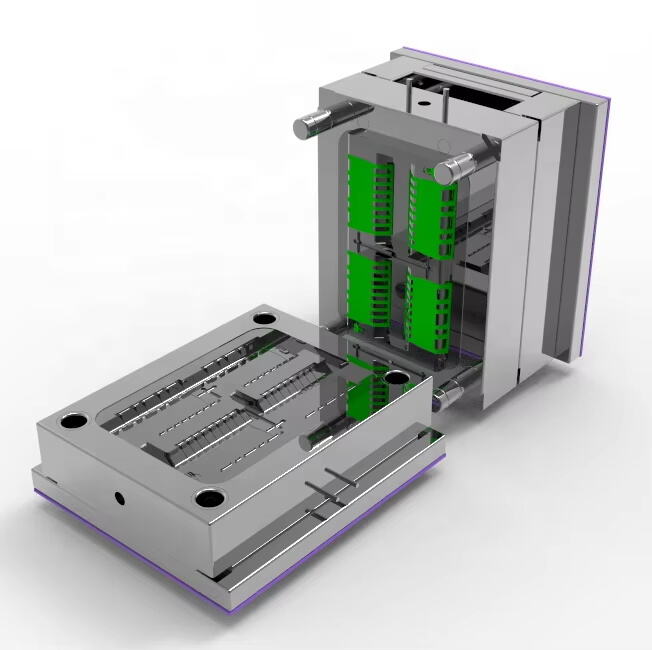Overview of Plastic Injection Molds
Plastic injection molds play a pivotal role in modern manufacturing by enabling the rapid and cost-effective production of complex plastic parts. These molds are integral to various industries, including automotive, consumer goods, and electronics, due to their versatility in creating components that range from small gears to large housings. The employment of plastic injection molds allows businesses to meet the high demands of precision and consistency required in today's competitive market.
Furthermore, the mold's design and quality have a direct impact on the final product. A well-designed mold is fundamental to maintaining product integrity, influencing factors like shape, durability, and performance. This is why mold design is a crucial aspect of production planning, ensuring that products meet specific industry standards and customer expectations. By understanding the importance of plastic injection molds, manufacturers can optimize their processes and achieve superior results in mass production scenarios.
Plastic Injection Molds vs. Other Types of Molds
Plastic Injection Molds: High Precision and Complex Shapes
Plastic injection molds stand out for their ability to produce high-precision, complex shapes with intricate designs. These molds are ideal for creating highly detailed components with tight tolerances and superior surface finishes. Being highly efficient, injection molds are perfect for mass-producing uniform items such as plastic housings, medical devices, and household products. Their accuracy and repeatability make them a preferred choice across multiple industries.
Die-Casting Molds: Features and Applications
Die-casting molds are generally used for processing metals and are known for their excellent production rates and dimensional accuracy. They are designed to handle metals such as aluminum and zinc, delivering high structural integrity components. However, the cost of materials and the design constraints make die-casting less suitable for large-scale plastic component production. The molds are more expensive and are not tailored for the versatility that plastic injection offers.
Compression Molds: Best Uses for Rubber and Thermosets
Compression molds specialize in handling rubber and thermosetting materials, focusing on producing larger, bulkier parts. This process involves placing a preheated plastic material into an open, heated mold, which is then closed and compressed. Although effective for creating substantial parts such as gaskets and circuit breakers, compression molds lack the precision and production efficiency of injection molds. Their limitations in intricate designs make them less ideal for high-volume runs.
In conclusion, while each type of mold has its own set of advantages depending on the material and the intended application, plastic injection molds offer unmatched precision and efficiency for mass-producing complex plastic parts. Their versatility, combined with their capacity for high-volume production, makes them indispensable in modern manufacturing processes.
Advantages of Plastic Injection Molds
Plastic injection molds are highly cost-effective for mass production. The primary reason for their cost efficiency is the reduced material waste, as this method allows for precise control over the amount of plastic used in each cycle. Additionally, the rapid production rates achievable with plastic injection molding mean that companies can produce large quantities of identical parts at a much lower cost per unit. This advantage is particularly beneficial for businesses that operate on a large scale, where minimizing production costs is crucial.
The versatility of plastic injection molds extends beyond cost savings, offering significant material versatility and design flexibility. Manufacturers can process a variety of thermoplastics to meet specific performance requirements, such as toughness, chemical resistance, or flexibility. Moreover, the ability to create complex and intricate designs with injection molds opens the door to innovative product solutions. This design flexibility allows companies to cater to a wide range of market needs, from medical devices to consumer electronics, ensuring their products meet functional and aesthetic criteria.
Conclusion: How Choosing the Right Mold Type Impacts Production Quality and Cost
The choice of mold type plays a crucial role in determining both the quality of the finished product and the overall production costs. For businesses planning to manufacture goods, selecting between injection, compression, or die-casting molds demands a thorough understanding of the product specifications, anticipated production volumes, and material compatibility. Each mold type offers distinct advantages and challenges; therefore, making the right selection can significantly affect the manufacturing process.
Investing in the appropriate mold type leads to several production benefits: enhanced efficiency, reduced material waste, and superior product quality, which collectively result in higher customer satisfaction. Efficient mold selection not only ensures that the production process is lean and cost-effective but also guarantees that the output meets or exceeds consumer expectations, thereby bolstering brand reputation and market competitiveness. Recognizing these impacts underscores the importance of thoughtful decision-making in mold selection.
FAQ
Q: What are the main advantages of using plastic injection molds?
A: Plastic injection molds offer high precision, cost-effectiveness for mass production, versatility in material use, and the ability to produce complex designs with efficiency, making them ideal for high-volume production.
Q: How does a plastic injection mold differ from a die-casting mold?
A: Plastic injection molds are designed for producing plastic parts with intricate designs, while die-casting molds are typically used for metals and are less suited for large-scale plastic part production due to cost and design constraints.
Q: Can plastic injection molds be used for all types of materials?
A: While plastic injection molds are primarily used for thermoplastics, they can accommodate a variety of materials to meet specific performance requirements but may not be suitable for rubber or thermosetting plastics which are better processed through compression molds.

